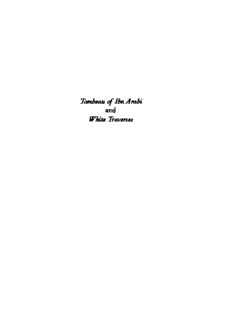
Tombeau of Ibn Arabi and, White traverses PDF
Preview Tombeau of Ibn Arabi and, White traverses
Tombeau of Ibn Arabi and White Traverses .................17510$ $$FM 09-16-0910:23:45 PS PAGEi .................17510$ $$FM 09-16-0910:23:46 PS PAGEii abdelwahab meddeb Tombeau of Ibn Arabi and White Traverses Translated byCharlotte Mandell fordham university press new york 2010 .................17510$ $$FM 09-16-0910:23:46 PS PAGEiii Copyright(cid:2)2010FordhamUniversityPress Allrightsreserved.Nopartofthispublicationmaybereproduced,stored inaretrievalsystem,ortransmittedinanyformorbyany means—electronic,mechanical,photocopy,recording,orany other—exceptforbriefquotationsinprintedreviews,withouttheprior permissionofthepublisher. LibraryofCongressCataloging-in-PublicationData Meddeb,Abdelwahab. [Tombeaud’IbnArabi.English] TombeauofIbnArabi;and,Whitetraverses/AbdelwahabMeddeb; translatedbyCharlotteMandell.—1sted. p. cm. Includesbibliographicalreferences. ISBN978-0-8232-3114-0(cloth:alk.paper) ISBN978-0-8232-3115-7(pbk.:alk.paper) 1.Meddeb,Abdelwahab—Childhoodandyouth. 2.Meddeb, Abdelwahab—Homesandhaunts—Tunisia. 3.Meddeb,Abdelwahab. Tombeaud’IbnArabi. I.Jean-LucNancy. II.Mandell,Charlotte. III.Meddeb,Abdelwahab.Blancestraversesdupasse´.English. IV.Title. V.Title:Whitetraverses. PQ2673.E34T6613 2010 843(cid:2).914—dc22 2009030653 PrintedintheUnitedStatesofAmerica 12 11 10 5 4 3 2 1 Firstedition TheworkscollectedherewerepreviouslypublishedinFrenchas Tombeaud’IbnArabi,withdrawingsbyAntonioSaura(Cognac:Fata Morgana,1995),andBlancestraversesdupasse´,withphotographsbyJellel Gasteli(Cognac:FataMorgana,1997),laterincludedinL’Exil occidental,(Paris:AlbinMichel,2005).Earlierversionsofportionsofthe translationspublishedhereappearedinTalus(ed.ShamoonZamir), Notus(ed.PatSmith),Parnassus(ed.HerbertA.Leibowitz),Boxkite (ed.JamesTaylor),andTheYaleAnthologyofFrenchPoetry(ed.Mary AnnCaws). .................17510$ $$FM 09-16-0910:23:46 PS PAGEiv contents vii Preface:OnTombeauofIbn Arabi andWhiteTraverses 1 TombeauofIbn Arabi 75 WhiteTraverses 109 Afterword:ThreeQuestionsabout Tombeauof IbnArabi jean-luc nancy 116 Notes .................17510$ CNTS 09-16-0910:23:53 PS PAGEv .................17510$ CNTS 09-16-0910:23:53 PS PAGEvi Preface On Tombeau of Ibn Arabi and White Traverses This Tombeau is not a question of praise or homage. It means to show how a text that maintains a link with the dead can be written at the present day. Of those dead, the living remember Ibn Arabi, who has neverstopped speakingto usthrough thewordsthat weave his phrases. From this privilege I draw an- other:hissurprisingclosenesstoDante.Theyarethe two symbolic figures who through history confirm mytwofoldspiritual genealogy, ArabandEuropean, Eastern-Western.Thisdualityrequiresgoingbeyond creeds and polarities so that one ceases to be only fromtheWestoronlyfromtheEast(liketheKoranic olivetree). What becomes evident upon reading Ibn Arabi’s Tarjuman al-Ashwaq1 and Dante’s Vita Nuova is the poet as interpreter of his own text, a text that places at the center of the poem the love inspired by the Lady: Niz’aˆm for one poet, Beatrice for the other. vii .................17510$ PREF 09-16-0910:23:57 PS PAGEvii With them is linked the name Aya, enriched by the long history of the exaltation of women by men, where the plurality of experiences remains marked bythesinglenessoftheName. My own experiences are channeled by all this po- eticmemoryintoasingularitywherecertainpilgrim- age sites between Paris and Carthage should be recognized, along with Italian (Siena, Florence, Rome),Andalusian(Ronda,Almeria),andMoroccan (the High Atlas) places, and other locations about whichI willhavetoremainsilenttopreserve amea- sureofsecrecy,mentioningonlyinpassingthemany deserts that appear throughout the stanzas—real de- serts in Africa and Asia, the conventional desert brought to us by the first impressions of the early poetry of the Arabs before Islam, the desert of the room whereintheMallarme´anartifactgleams. What else can I say about the foregrounding of theirregular(inheritedbothfromIbnArabiandfrom Dante)? This irregularity becomes manifest through a prose haunted by alexandrines hidden between commas: in the flow of prose is hidden the elusive scansion of syllables. The twelve syllables that form the alexandrine get thrown off track, going under or viii .................17510$ PREF 09-16-0910:23:57 PS PAGEviii over, for no other reason than to outwit the fixed countofsyllablesandtowelcometheruleoftheodd number. In this rhythmic scansion lives one of the mysteries of the comma, which has an unexpected usage, heredeliberately rebellious tosyntactic order, as if to signal by its mark the presence of a voice intended to give life to the poem. So the comma is the sign that, in the heart of the written text, there soundsthe phantomof thespoken word.Know then that, from contraction to dilation, the breath, in its movements and its rest, will overflow grammatical logic.Sothereadershouldknowthatthesepages,in their fullness and their emptiness, ought to be heard accordingtolisteningtothediscontinuousandtothe discordant,asiftokeepfromglossingoverwhatever doesnot runsmoothlyinthisworldthatabsorbsus. Here, evil and sickness are portrayed in all the theatricality of love. They nourish the attributes of beauty according to the role assigned to them by re- ality. And theyare present only inthemselves, with- out being driven away by the good. The duality of good and evil is here interlinked, with no loopholes or evasions. Here contraries are united according to a tension that varies from maximum to minimum. ix .................17510$ PREF 09-16-0910:23:57 PS PAGEix Such a disposition is not the exclusive privilege of our orphan era, which, after Ho¨lderlin, after Nietz- sche,buildsatombevenforGod.Iseeiteveninthe heart of previous eras. In truth, it remains lurking in the Unconscious of space and time. Revealed to me by frequent visits to the actual tomb of Ibn Arabi, a monument that still houses the ashes of the one who was born in Murcia in 1165 and died in Damascus in 1240. Situated in the Ayyubid neighborhood of Salihiyya, at the foot of Mount Qasyun, this Dama- scene tomb was rebuilt in the sixteenth century; in Ottoman fashion, its walls are decorated with glossy ceramic tiles where vegetal motifs drawn in blue standoutfromawhitebackground;butsuchsuppos- edlyfloralmotifsaretransformedintomasksofdev- ils, surprisingly calling to mind the mannerist aesthetic called ‘‘grotesque.’’ It is as if the eye ema- nating fromthe tomb wereordering us neverto lose sight ofthe duty of lookingevil in the faceand con- vertingitintowhatispeaceful.Theserenitybrought bylaughterafter thepurificationoftears. AndintheclimatewhereIwasbornandgrewup, on the African coast that looks toward Europe while beinglappedbythewavesoftheMediterranean,itis x .................17510$ PREF 09-16-0910:23:58 PS PAGEx
Description: